Continued from Part 1...

The summers of 2012 and 2013 had come & gone before I finally set out to reach Chimney Cove.
It was early June and one of our first nice weekends, this late spring day feeling more like summer. It would have been much easier to linger on the back deck with Christian, Tasha & Steve, but I've always had trouble with staying idle. I made myself pack up my things and head north for Trout River.
The hills back here behind the Tablelands shined in a different light outside of those grey November skies. They were now inviting and pleasant, welcoming me to stop and hike the Trout River Pond trail if only I had more time. Since I had wandered around the town of Woody Point along the way, I now only had time for evening light at my hopeful destination.
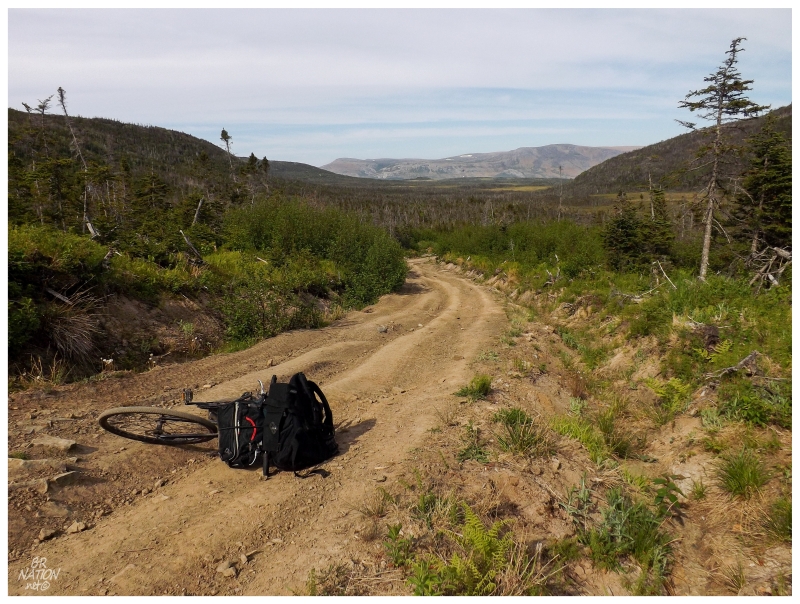
My Intrepid made it further than before because I knew that the hills were passable and minor from my earlier scouting trip.
Parking at a wide section of the road where it looked like most people turned around, I then moved up and down the same rolling hills with my bike, climbed up the steep hill where I left my bike in 2011, then cycled across the rutted plateau.

The drop down to the river was a fun adrenaline rush, where I was thankful for all of my time spent at the skatepark. There were periods of leaning back to avoid going over the handlebars, as well as shifting my weight and carving to avoid rocks at speed, which all added to the experience. I knew of someone else who wanted to ride a bike back here & I thought about whether they'd be able to handle navigating the same road without my bike control.
There were a few cabins along the way and the road was better in front of them, but then you'd cut downhill and spots where even an ATV would slow, meant that you were fingering the brakes forcefully and craning your neck as to what was ahead.

The road flattened out and my bike tires were touching the banks of the Gregory River. I noted how close I was to the village and stored my bike up a northbound trail. Curious as to where such a fine trail led in this supposed wilderness, I forced myself back to the area where it seemed like everyone crossed through the river.
It was about 5 years before this that I crossed a very similar river - Fox Island River - in the early spring. I remember the throbbing pain in my feet and frigid water upon my thighs from that river, a river that's similarly fed by the Long Range Mountains before spreading out to a wide expanse near the ocean. Thankfully the Gregory wasn't as wide, deep or cold, partly because of it being June instead of May. The rocks all along the bottom were very small and painful as they intruded into my arches, but on the other side of the river there was only a minute of foot grabbing and rubbing for warmth.
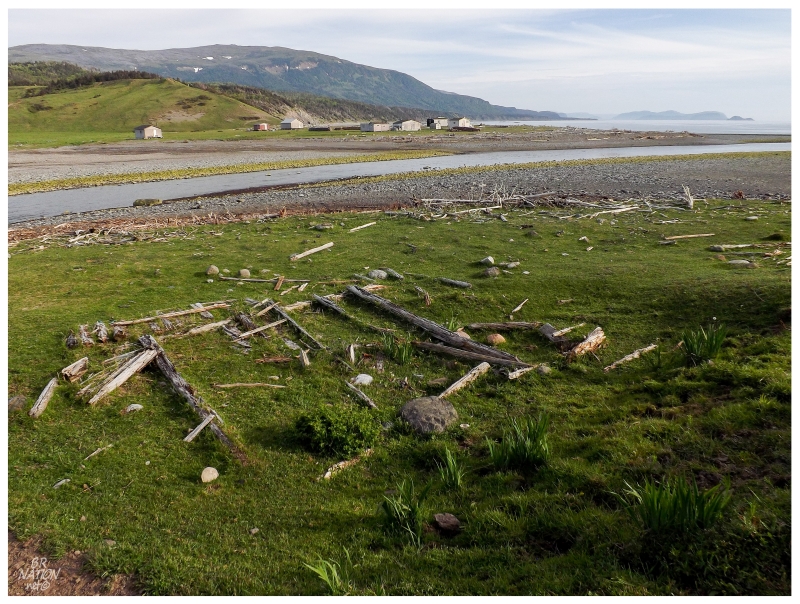
Chimney Cove shed ruins on the north side of Gregory River.
The Gregory River meandered and made me wonder if I had crossed at the right spot. I walked ahead on rocky ground for a short while before sourly realizing that I was on an island and needed to take my shoes off once again.
Having enough of the Gregory River, I dived into the riverside forest thinking that Chimney Cove must be right ahead. What was impressive about the forest was just how thick it was for a small sliver of woods near the ocean. I fought my way through tangles of small trees, while trying to avoid murky water and abundant moose patties. Wondering why there was so much shit in this forest, I later figured out that it was cow manure instead of moose. I was that close to the cabin community and the farm animals kept there.
The forest finally relented and I popped out right in front of someone's shed. I had finally made it to Chimney Cove. I quickly left behind their property for a wide expanse of flat grass, where a worn trail led the way around cabins, sheds and horse-grazed pastures.
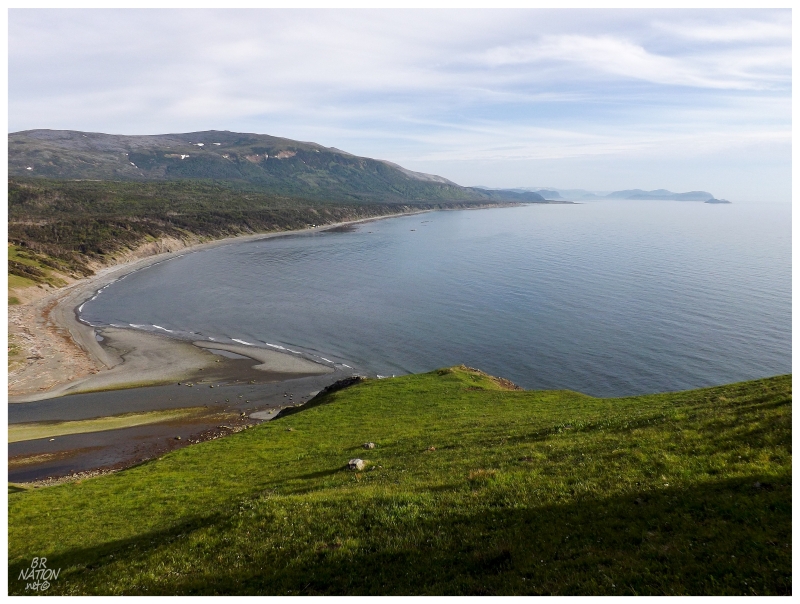
A few minutes of walking brought me to the cabins at the shore and an inviting, grassy beacon of a hill to the north. I truly didn't feel like taking off my hiking shoes & walking barefoot across frigid rocks for a third time (and fourth and fifth on the way back), but how could I pass up such beauty?
Every step forward and upward towards Chimney Cove Head was another step towards stopping to lightly curse and take in the beauty before me. Tweed Island and Guernsey at the mouth of the Bay of Islands, this grassy valley of Chimney Cove, Mount St. Gregory in the center. I pondered if this was one of the top 10 prettiest places I had seen on the island and it would be in the conversation. This evening and the scenery was sublime.

Chimney Cove Head.
If the seaside grassy meadows confuse you because they aren't the normal stunted trees of this island, it's because cows still graze here at Chimney Cove, munching the grass amazingly close to these cliffs of certain death. This was evident when I moved close enough to the cliffs to make myself nervous, but there was still cow shit near my feet. The cows' proficiency at grass trimming is even more apparent because of a rare plant at Chimney Cove, where there's very few plants and they are only right at the edge or on lips past the edge, as all other locations are threatened by cattle.
This clearing has actually been here for approximately 175 years now, as the earliest known part-time residents of Chimney Cove, Phillip or Matthew Payne, cleared the land and built houses/outbuildings here atop Chimney Cove Head in the 1840s and 1850s.
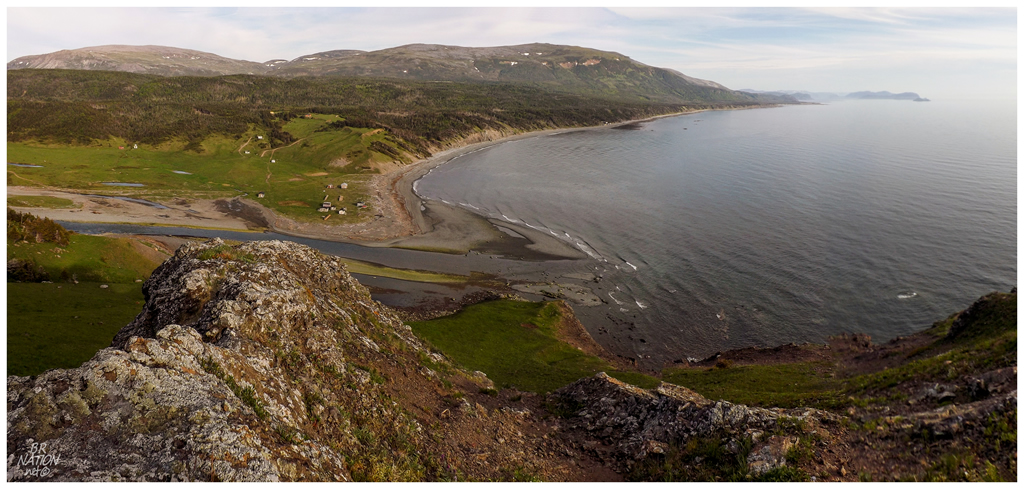
The first full time residents would come to Chimney Cove in 1880. Almost all of the information I'll recite here comes from a fantastic document where an old resident sat down and compiled all of his knowledge of this place and its residents - this account was written by Eli Payne in 1995 and his grandparents were those first settlers. Their house had burned down in Trout River & they had been coming to Chimney Cove throughout the year except for winter anyway, so they decided to move to Chimney Cove to build their new, year-round household.
The Paynes claimed a piece of large, dry land with good soil for their home, leaving the second settlers to less optimal land, then leaving future residents to soil with high clay content inconveniently located on the hillside.
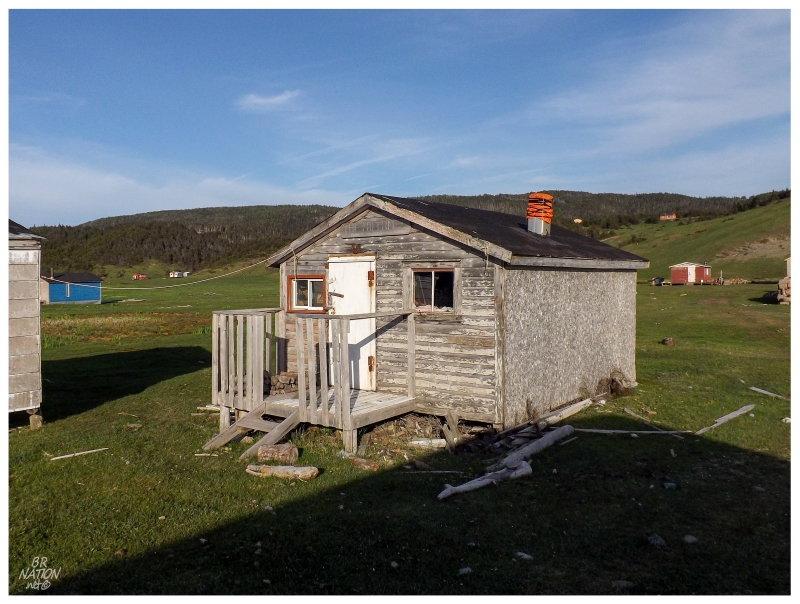
Chimney Cove was an isolated settlement here because of the steep hills dropping almost vertically into the ocean throughout this coastline. Outside of Trout River, Cox's Cove and then Goose Arm/Penguin Arm settled inward on bays, you only had very small seasonal settlements at Crabbs Brook and Shoal Point along tens of miles of coast.
Therefore a place like Chimney Cove had its appeal because it was the only choice located right on the Atlantic Ocean, providing great access to grounds of abundant lobster. By 1884 the census said that 100 people lived at Chimney Cove, the fishermen here producing one of the highest lobster catches per capita along the west coast. A Church of England chapel was built and residents also started to catch herring and use the good soil for farming.
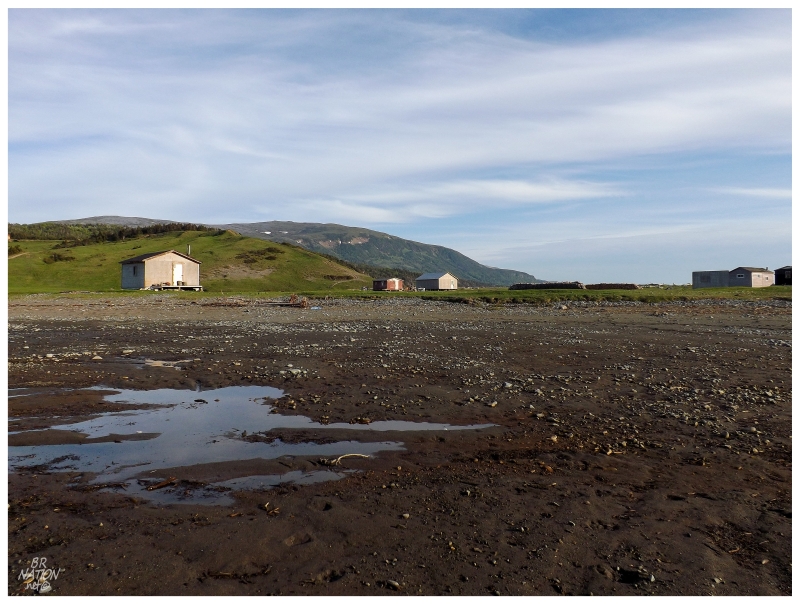
Eli Payne states that by the 1920s, the younger people weren't happy with the isolation and most everyone moved away as they became of age. In addition, no new residents relocated to Chimney Cove. This meant the same problems for Chimney Cove that the isolated places of Newfoundland face today - an aging population with no one replenishing the stock.
Eli himself left for Cox's Cove in 1939, around the time that a string of deaths really struck this place hard, since the population was limited and Chimney Cove felt isolated enough on its own. He states that "with so many people dying, it was hurting and it became a lonely place to live." Three other families left in 1940, Peter Buffett's to Meadows, Henry Buffett's to Cox's Cove & James Gillingham's as well.
The Encyclopedia of Newfoundland states that there were 9 people in Chimney Cove in 1966, but Eli states that the last person to leave was John Butler in 1964 or 1965. Eli knew that John was still there in 1963 after asking about him, since John had brought Eli's sick uncle to Trout River in 1961 by boat, where the uncle then was driven to Cox's Cove and died shortly after.
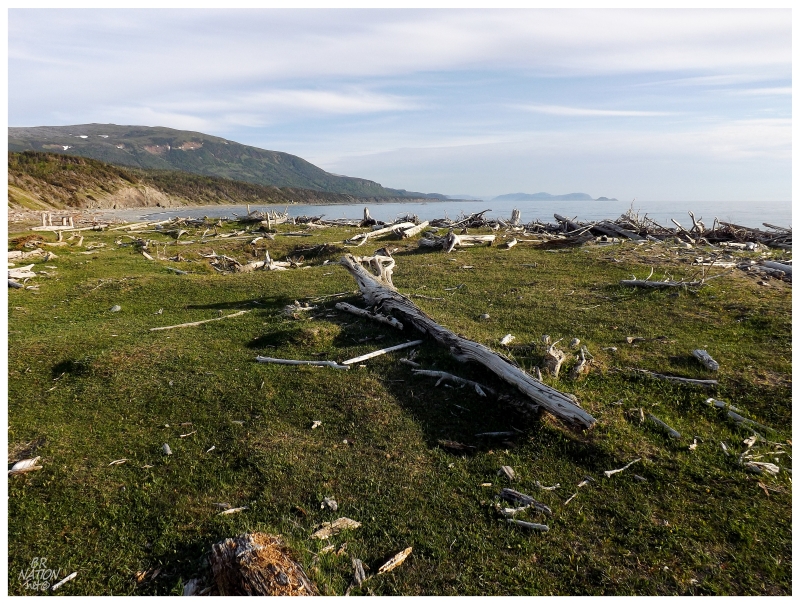
Eli returned to Chimney Cove for a visit in 1977, reporting that all of the homes and outbuildings were burnt to the ground, save for a few fishing shacks by the shore. He was there in part to visit his father's grave, something that displeased him because someone had made off with 20ft of wire that was left there.
Eli's father would be one of the four unmarked graves at Chimney Cove, along with only one grave marked with a headstone. I knew this while visiting Chimney Cove & I also knew that the headstone wasn't easy to find, so I didn't commit any of my limited time to searching. Unfortunately for me, the headstone can't be that elusive as a cemetery transcriber was able to find it in the year 2000. I should have taken a look on the hillside.
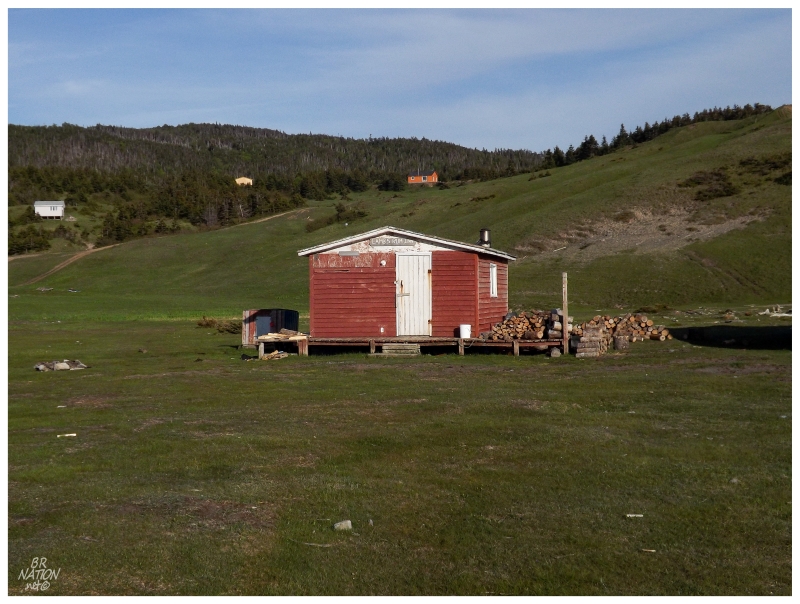
All of the Chimney Cove cabins had wooden signs above their door with a cabin name involving the word 'inn'. There was the Hilton Inn and I came out of the forest at the Just The Tip-Inn (lol). The above inn is one you'd see in a lot of Newfoundland places - the Lambs Rum Inn.
In recent years Chimney Cove has recovered some of its bustle because Trout River continues to exist as a healthy Newfoundland town. This provides local people who want to have a cabin secluded along the shore, people who want to get away and enjoy some peace and quiet outside of the Trout River rat race.
I counted 7 people at Chimney Cove during my brief visit, so who knows how many were actually there in the cabins on the hillside or avoiding the yahoo who mountain biked out to their cabin community.

Horses grazed in the valley, but kept their distance from me throughout my visit.

One couple sent their 13-year-old son over to check up on me and make sure I was okay.
Of course I was perfectly fine and just about to head on my way back home - to which he offered me an ATV ride back to the river! Nice!

I bounced along on the back as he navigated the paths of Chimney Cove, trying to take a picture of this hilarious experience with the proper exposure settings on my camera. The best part was when we came to a cow in the way, where he hollered "get out of the way, luh! B'y luh!" at the Newfoundland bovine, while he inched forward on the ATV and pointed the cow away from the path.
Yelling Newfinese at a confused and stationary cow put a smile on my face from ear to ear.
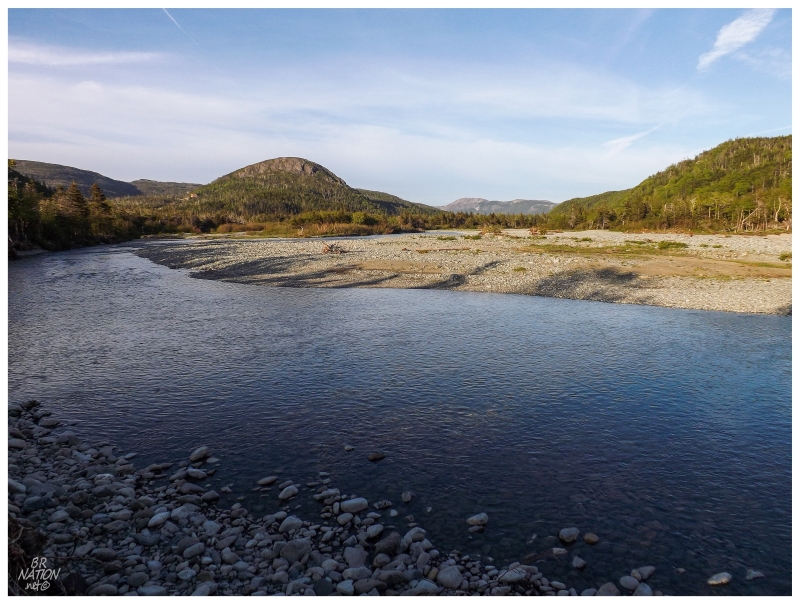
The teenager dropped me off at a nice riverbank spot where he said I'd only have to cross once. Here I had hoped he would drive through the river, but no such luck. The total number of barefoot river fords would be five for the day.
It really was a shame that I wasn't prepared to camp overnight at Chimney Cove on this idyllic evening. Nowadays I would be easily convinced to go back on a similar night.
I retrieved my bike, pushed it up the steep incline and sped down the inland hill towards my waiting car. Returning home, the b'ys were all out on the deck & I was able to catch up, in addition to having seen another resettled (and stunning) place here on the island.